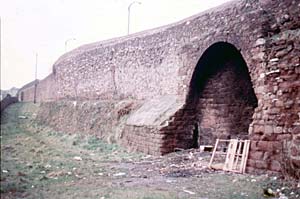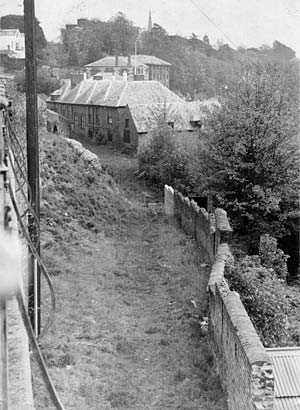
Cricklepit Street
Page updated 20 June 2009
Not always known as Cricklepit, this lane was once the eastern end of Rackclose Lane. It became Cricklepit Lane in 1868, when memories of the rackfields on Shilhay where fading. John Gendall drew an illustration of the Cricklepit end of Rackclose Lane in 1848 for Thomas Shapter's History of the Cholera; it shows children playing amongst the pigeons, ducks, chickens and pigs, all squeezed into a narrow lane of hovels on one side and city wall on the other.
Gendall's drawing really gives some idea of the state of the street, but it can deceive, There were 11 deaths from the cholera, certainly not one of the highest rates in the city; 43 died in Preston Street and the very short Stepcote Hill had 15 deaths. Forty years after the cholera outbreak, Cricklepit Lane was still a street at risk of disease, and in January 1872 there was a case of typhoid reported in the lane of an unvaccinated child, who died as a result.
Where there is poverty and deprivation, there follows organisations pledged to help, both materially and spiritually. The Westquarter saw several missions and religious organisations in the late 19th-Century, most advocating temperance. The Exeter Christian Mission ran the Cricklepit Mission Hall, with services every Sunday, and out of doors meetings in the streets of the Westquarter.
World War One Dead - Cricklepit
Private, E J Collins, Devonshire Regiment. 10 March 1915. Age 26. Cricklepit Hill
Cricklepit derives
from crickenpette,
meaning pit or
hollow beneath the cliffs and creic, an old word for rock or crag.
Nicholas Gervase was granted in 1180 to
1190 by Robert de Courtenay the right to all the water flowing between
the corn mills of Thomas the Miller and Crickenpette. Despite at least
five fulling mills lining the leat below Cricklepit/Rackclose Lane,
Cricklepit Mill had always been a corn mill.
In the 1960's, most of the leat was culverted and Cricklepit Mill of Messrs
French was the only remaining mill, of the many mills,
that once lined the leat and helped to make Exeter rich on serge
production. The suspension bridge with the same name was built in 1988.
Ewings Lane appears to have been referred to as Cricklepit Lane in the early part of the 1850s.
 Cricklepit
Lane by the city wall. Photo ALan H Mazonowicz.
Cricklepit
Lane by the city wall. Photo ALan H Mazonowicz.
 Cricklepit Lane in the 1960s. Photo
Dick Passmore.
Cricklepit Lane in the 1960s. Photo
Dick Passmore.
│ Top of Page │